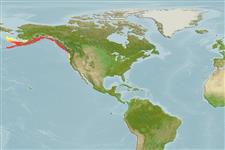Environment: milieu / climate zone / depth range / distribution range
Ecology
Marine; demersal; depth range 73 - 225 m (Ref. 51661), usually 73 - 223 m (Ref. 2850). Temperate
Eastern Pacific: eastern Aleutian Islands to Puget Sound, Washington. Records from the Bering Sea, western Aleutian Islands, and Sakhalin Island are questionable.
Size / Weight / Age
Maturity: Lm ? range ? - ? cm
Max length : 30.5 cm TL male/unsexed; (Ref. 4925)
Inhabits subtidal to 225 meters (Ref. 51661). Feeds on crustaceans (Ref. 4925).
Life cycle and mating behavior
Maturities | Reproduction | Spawnings | Egg(s) | Fecundities | Larvae
Eschmeyer, W.N., E.S. Herald and H. Hammann, 1983. A field guide to Pacific coast fishes of North America. Boston (MA, USA): Houghton Mifflin Company. xii+336 p. (Ref. 2850)
IUCN Red List Status (Ref. 130435)
Threat to humans
Harmless
Human uses
Tools
Special reports
Download XML
Internet sources
Estimates based on models
Preferred temperature (Ref.
123201): 2.9 - 8.1, mean 5.3 °C (based on 248 cells).
Phylogenetic diversity index (Ref.
82804): PD
50 = 0.5000 [Uniqueness, from 0.5 = low to 2.0 = high].
Bayesian length-weight: a=0.00525 (0.00237 - 0.01161), b=3.15 (2.96 - 3.34), in cm total length, based on LWR estimates for this (Sub)family-body shape (Ref.
93245).
Trophic level (Ref.
69278): 3.5 ±0.50 se; based on food items.
Resilience (Ref.
120179): Medium, minimum population doubling time 1.4 - 4.4 years (Preliminary K or Fecundity.).
Fishing Vulnerability (Ref.
59153): Low vulnerability (21 of 100).
